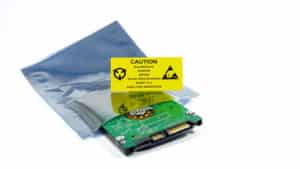When it comes to manufacturing, one of the most important aspects to consider is safety. In particular, ESD bags can play a critical role in preventing electrostatic discharge (ESD). This article will discuss why ESD control is so important in manufacturing and how ESD bags can help. We’ll also take a look at some key considerations when selecting the right bag for your needs.
ESD bags are one of the most preventative and effective methods used against ESD to protect electrical components and devices from static discharge. These bags were first utilised in the late twentieth century beginning with pink poly bags in the 1960’s, followed by static shielding bags in the late 1970’s. Over recent years, moisture barrier bags have been widely utilised in Surface Mount Technology (SMT). They have also proven to be effective for use in the military industry.
There are three types of primary threats that electronic devices should be protected from.
1) Direct Discharge (ESD) – A direct static discharge to a bag can affect the electronic device inside and cause it to melt, fuse the circuit, or reach a very high current.
2) Static Fields – Static fields can cause destructive currents in circuit conductors. Field differentials can break down the circuit dielectric.
3) Tribocharging – Friction between the electronic device and bag can create damaging static voltage and fields.
There are many types of ESD bags available in the market that can protect electronic devices from these primary threats. The most commonly used in electronics manufacturing are static shielding bags, anti-static bags, and moisture barrier bags.
A static shielding bag is a type of packaging material used for storing and transporting static sensitive electronic devices and components such as PCBs, semiconductors, computer CPUs, integrated circuits and TTL chips. Static shielding bags provide a conductive barrier, known as a ‘Faraday Cage’, around your electrical components to ensure full electrostatic discharge protection.
Anti-static bags, on the other hand, provide safe transportation and storage of non-static sensitive items (e.g. nuts, bolts) into an electrostatic protected area (EPA). Unlike the static shielding bag, they are made from low-charging materials which minimise the build-up of static charge. While they have no shielding ability to protect the electronics inside, they will not build-up a charge if rubbed against another material. Often, anti-static bags can be confused with static shielding bags. It is always wise to check the properties of the bag before purchasing to assure you are selecting the right type of bag for your needs.
Moisture barrier bags have a slightly different function to the two bags mentioned above. These bags are specifically used to store and transport electronic devices and components such as PCBs, SMDs and integrated circuits that are susceptible to both static and moisture damage. They are suitable to use in humid environments and most are Jedec compliant. To prevent moisture damage to the contents inside, the bags have a layer of aluminium which blocks the moisture from entering the bag.
As such, these bags are considered essential packaging components within ESD protected areas (EPA) in industries such as electronics manufacturing.
ESD bags play a significant role in safely holding components used in electronics manufacturing. They are an ideal solution for handling, storing and transporting parts such as nuts and bolts, RAM chips, motherboards, circuit boards, flat panels and hard drives.
To comply with the necessary IEC-61340-1-5 International Standard, it is crucial to maintain appropriate static control when handling, storing and transporting electronic components. ESD bags help ensure that these standards are met.
Aside from minimising the risk of electrostatic discharge, an ESD bag is also capable of protecting its contents from mechanical damage, dust contamination and corrosion. This makes shielding bags and anti-static bags crucial for a company dealing with electronics. With ESD control measures such as protective packaging in place, a company can better safeguard its products, ensure quality and meet customer satisfaction.
Here are some of the key considerations to note in selecting the right bag.
Consider what you will be using the bag for. An essential question to ask is: in what specific applications does the bag come in handy?
If you’re looking to pack non-ESD sensitive (ESDS) components inside an EPA, then you can opt for an anti-static bag. Meanwhile, conductive bags offer a layer of protection and some shielding for most ESDS items.
Shielding bags are a great pick if you need to pack and transport ESDS components, as they provide excellent protection against ESD damage. There are also moisture barrier bags, which are specifically designed to keep your electronics protected from corrosion and moisture while they’re in storage.
The many types of ESD bags serve different functions, which means they’re also constructed from different materials.
Anti-static bags are typically made from industry approved polyethylene laminates with an anti-static coating. Conductive bags are made from polyethylene as well but loaded with carbon.
Shielding bags consist of layers of static dissipative polyethylene, aluminium shield, polyester, and topped with a static dissipative coating. You have the option of getting shielding bags with bubble cushioned layers. By absorbing impacts and preventing damage, high shield cushion pouches offer added protection to electronics.
Moisture barrier bags are made of static dissipative polyester, aluminium shield and static dissipative polyethylene. For maximum shielding capability, a moisture barrier bag can be constructed using a heavy metallised structure. Moisture barrier bags with a metallised structure are equipped with layers of static dissipative polyester, aluminium shield, static dissipative propropylene and topped with a static dissipative coating.
Another factor to consider is the characteristics of the bag. Does the bag come with low-charge generation properties? What’s the electrical resistance of the bag’s materials? Is the bag thick enough to properly hold electronics? Will the bag be big enough to fit my electronic device?
Does it create a Faraday Cage effect? Shielding and moisture barrier bags have a Faraday Cage feature, effectively protecting the bag’s contents from ESD.
Other features to consider are puncture resistance, durability and whether the bag comes with a resealable grip. It’s also crucial that the bags satisfy the necessary technical requirements.
Generally, bags that offer shielding protection are higher in cost compared to bags with little to no shielding properties. This makes anti-static bags the least expensive among the types of ESD bags. Meanwhile, shielding and moisture barrier bags are more high-end. Conductive bags are lower in cost than shielding and moisture barrier bags but slightly higher than anti-static bags.
Anti-static bags are generally recommended to be used within 2 years. For shielding bags, their typical shelf life is more than 3 years. Conductive bags, on the other hand, can have a shelf life of more than 5 years.
Choose an appropriate bag size for the items you’re planning on handling, storing or transporting. ESD bags vary in size, from ones that can hold microchips to bags that will allow you to store motherboards.

A: You can tell that a bag is anti-static by testing its surface resistivity and assessing its physical appearance. An anti-static bag generally has a clear or tinted appearance. Although distinct for their pink colour, anti-static bags can also come in other shades such as blue or green. Additionally, an anti-static bag should have a resistivity between the dissipative range of 10^(9) to 10^(11). They are humidity dependent.
A: A specific type of ESD bag, black poly bags, are made from conductive materials. With a resistivity between 10^(3) to 10^(4), conductive bags allow for the fast dissipation of charges. Although black poly bags provide a small level of shielding (<30%), they do not have a dielectric layer to isolate a device inside.
A: Static shielding bags prevent static electricity from building-up by providing a conductive barrier, known as a Faraday Cage. At the same time, they protect components inside the bag from static damage due to electrostatic discharge. Meanwhile, static-resistant or anti-static bags also minimise static electricity build-up. But unlike static shielding bags, they are not capable of providing effective protection to static sensitive devices inside the bag against ESD events.
A: Pink bags used in EPAs have anti-static properties to prevent static electricity from accumulating. However, they have no shielding ability and therefore should not be used to store or transport electronic components. An electrostatic field or discharge that takes place outside of the bag will penetrate the bag and damage the electronics inside. Aside from this colour, there are also green and blue anti-static bags available.
The right ESD bag is the one that provides you with the best static control protection for your working environment. Protect your electronics from the risks of electrostatic discharge with Bondline’s range of ESD bags.
Looking for bespoke anti-static bags? Bondline accepts requests for customising bag thickness, size, print and more. Contact us today to learn more.
Fields marked with an * are required
On selected products if ordered before 1pm
Dedicated account manager to help your ordering process
Great value on premium quality products
Bondline Electronics Ltd are a leading manufacturer and supplier of static control products within the ESD industry. Products such as Flexible and Rigid Packaging, Bench Matting, Wrist Straps, Heel Grounders and Shoes, ESD Protective Clothing and Gloves, Test and Measurement Equipment along with many storage and handling solutions.
Bondline products are all qualified and compliant according to IEC-61340-5-1 International Standard.
Registered Company Number: 02933918
Office Hours: Mon – Thurs: 9am – 5pm Fri: 9am – 2pm

Bondline Electronics Ltd are a leading manufacturer and supplier of static control products within the ESD industry. Products such as Flexible and Rigid Packaging, Bench Matting, Wrist Straps, Heel Grounders and Shoes, ESD Protective Clothing and Gloves, Test and Measurement Equipment along with many storage and handling solutions.
Some of these cookies are essential, while others help us to improve your experience by providing insights into how the site is being used.
For more information and to read more about our privacy policy, please visit our Privacy Policy
Necessary cookies enable core functionality. The website cannot function properly without these cookies, and can only be disabled by changing your browser preferences.